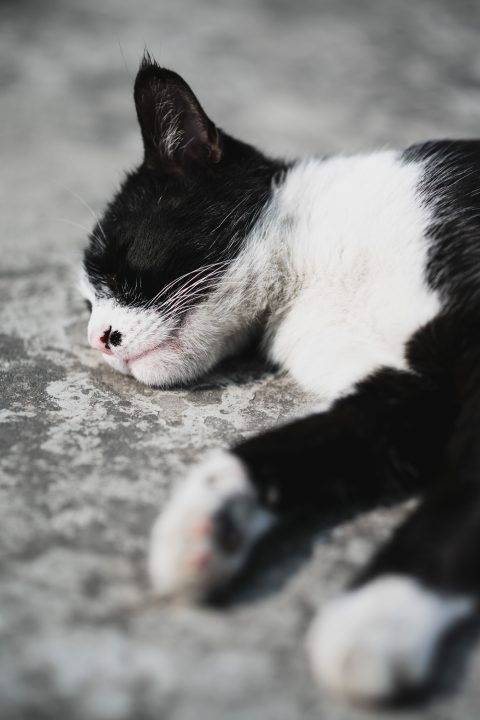Your vet prescribed Benadryl for your cat. You gave it to them as stated on the instructions. Now, they are foaming at the mouth. This sight of your cat shaking their head and salivating all over the place is no doubt alarming. But it’s also a normal reaction. Let’s look at the reasons why a cat would foam at the mouth after taking Benadryl or another medication.

Table of Contents
- Is It Normal For Cats to Foam at the Mouth After Medication?
- What Does Benadryl Do For Cats?
- How to Give Benadryl to a Cat?
- How Can I Stop a Cat From Benadryl Foaming?
- When Should I Worry About a Cat Benadryl Foaming?
- Don’t Panic Over Drool
- FAQs
Is It Normal For Cats to Foam at the Mouth After Medication?
Cats foam at the mouth when they have tasted something horrendously unsavory or bitter, such as medication. Some medicines also list hypersalivation (also known as drug-induced sialorrhea) as a side effect. When a cat gets something gross on their tongue, they produce an excessive amount of saliva instinctively to clear the taste. While this looks dramatic and frightening, this reaction is fairly common and harmless.
If your cat has to be given metronidazole (Flagyl), diphenhydramine (Benadryl), or something similar, you should expect foaming and salivation.
What Does Benadryl Do For Cats?
Benadryl is an antihistamine that people regularly use to treat allergic reactions. The active ingredient in Benadryl is diphenhydramine, which is also the name of the generic medication. If your vet prescribes Benadryl for your cat, it is because it is perfectly safe and potentially life-saving—in the event your cat is having an allergic reaction.
Common use of Benadryl for cats:
- Allergies
- Allergic reactions, such as insect bites or ear mites
- Motion sickness
- Itchy skin and excessive scratching
- Sedative (for long car trips, for example)
Common Benadryl side effects in cats:
- Excitability
- Lethargy
- Vomiting
- Diarrhea
- Suppressed appetite
- Dry mouth
- Urinary retention
- Hypersalivation (foaming)
Can I Give Benadryl From the Store to my Cat?
Since Benadryl is an over-the-counter medication that you can easily find anywhere, you may be wondering, “Can I use human Benadryl on my cat?” For humans, the Benadryl from the store is perfectly safe and fine to use. However, you should not give the same Benadryl to your cat. The Benadryl made for your pets is controlled and utilized differently, so your vet will have to write a prescription for it.
What Happens If You Give a Cat Too Much Benadryl?
Just like in people, Benadryl can cause a wide range of side effects in cats. Your pet may be excessively sleepy for a few hours. Other times, your cat may act hyper after their dosage. However, you should only give your cat the amount prescribed from the veterinarian. If you give your cat too strong a dose or use the wrong kind of Benadryl, there is a risk of overdose.
Overdosing on Benadryl may cause your cat to have a seizure, struggle with breathing, fall into a coma, or even die. Excessive drooling and foaming is generally not a symptom of overdose unless compounded with other symptoms.
How to Give Benadryl to a Cat?
The most common way to dose a cat with Benadryl is with a syringe. However, since the smell and taste is foul to cats, they may refuse to take it outright. You can discuss other options with your veterinarian. For instance, in some cases, your vet may recommend a flavoring, such as fish or chicken. If your vet can fill prescriptions, they may be able to add the flavoring on their own.
Sometimes, you may receive Benadryl in pill form for your cat. Pills can also be flavored or crushed up into a cat’s wet food.
Benadryl is often offered at 1mg per pound of weight. On average, cats receive between 10-25mg of Benadryl in pill form. For liquids, Benadryl is about 4ml for 10 pounds (around 12.5mg/5ml).
This video explains how to give medication like Benadryl to your furry friend:
How Can I Stop a Cat From Benadryl Foaming?
Since hypersalivation after a cat takes Benadryl is to be expected, there is really no way to stop it from occurring. The best way to try to limit the amount of foaming is to administer Benadryl with a syringe. By taking the correct steps to giving liquid medication to a cat, you should have little foam to deal with.
You can also distract your cat with something delicious after they take their medication. For example, lactose-free milk or tuna juice are excellent treats.

When Should I Worry About a Cat Benadryl Foaming?
Rarely is a foaming mouth any cause for alarm. However, if you notice additional symptoms alongside hypersalivation, or if you have not given your cat any Benadryl for a while, you should call a vet. It could be poisoning.
Here are some other symptoms to look out for:
- Dental problems
- Ingestion of plants with oxalate crystals, such as pothos
- Nausea
- Discomfort
- Foreign object in mouth
- Licking at flea medication
- Vomiting and reflux
- Rabies or pseudorabies
- Liver problems
- Teething
If you suspect that your cat has been poisoned, eaten something toxic, or has taken too much Benadryl, do not wait to call your vet. Prolonged their condition will only worsen the symptoms and may result in irreversible damage or death.
Don’t Panic Over Drool
Sure, cats do not drool as much as dogs, but when they taste something gross like Benadryl, they might start foaming at the mouth. Is a cat foaming from Benadryl a problem? Nope! It’s merely a reaction and should not be a cause for concern. The only time you should call a vet over a foaming mouth is when other symptoms, such as vomiting and pain, accompany the hypersalivation.
FAQs
It’s merely a reaction and should not be a cause for concern. The only time you should call a vet over a foaming mouth is when other symptoms, such as vomiting and pain, accompany the hypersalivation.
Cats may become drowsy, lethargic, or appear “drunk” after taking the medication. Benadryl can cause a decrease in saliva production, leading to a dry mouth. It can also cause dryness in the eyes. Some cats may experience gastrointestinal upset, including vomiting and diarrhea.




